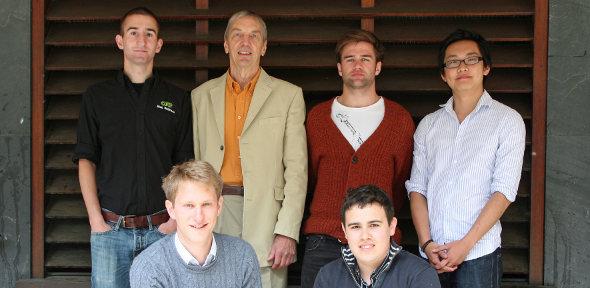
Melted cheese and boomerangs were the order of the day when students from a Cambridge secondary school visited the Department to see demonstrations of cutting edge Engineering projects.
This has really changed my perception of engineering - I hadn't realised what a wide ranging subject it was, or how creative an engineer can be.
Natalia Adamson, year 10 student
The final day of term saw recipients of this year's James Dyson Foundation Undergraduate Bursaries hold an open morning for year 10 students from Parkside School. As part of their award, the final year Engineering students are expected to present their projects to other young people in a manner which will inform, educate and inspire them. Invited guests included some of the academics involved in supervising the projects, along with Tom Dyson, brother of James Dyson the inventor, industrial designer and founder of the Dyson company and the charitable James Dyson Foundation.
The Bursaries were established in 2011 to support fourth-year undergraduate student projects in Engineering Problem Solving and Design. The awards are targeted at projects which offer excellent opportunities for outreach work in schools and include individual bursaries of up to £1,000.
Students Wai-chuen Cheung, Fraser Atkins, Will Vernon, Alex Robinson and James Blood made presentations to the school students which involved demonstrating how wings work, projectile motion, solar powered cards and 3D printing. Paul Mallaband presented his project on Arduino electronics separately during an off-site school visit. Demonstrations and hands-on practical sessions saw the Parkside students simulating the effects of a 3D printer by using syringes full of melted cheese and tortilla wraps before moving onto building their own solar powered vehicles and mastering the tricky art of origami to create their own paper boomerangs.
Will Vernon commented: "I really enjoyed interacting with the students, it was great fun to hear their ideas and thoughts on the lecture subjects. I found it quite tricky to present to them on a new topic, and to explain the relevant engineering principles in a simple and understandable way but I was very impressed by how some of the teams approached the 3D printing task by coming up with very different and sometimes ingenious ways to build the tallest tower that none of us had thought of."
Alex Robinson, a member of the Cambridge University Eco Race team, showed how to build a basic car which could be powered by a solar cell and was impressed by how engaged the young students were with the task. He said: "I was impressed with the cars produced - the students obviously thought through the design, with some choosing to make three-wheeled versions to save weight, or even a four-wheel-drive version using two kits. I was surprised how involved the students were with the activity, as they were all very keen to get a working vehicle by the end, and clearly enjoyed testing them. Hopefully they could also see the links to real-world engineering design challenges."
The morning session was summed up by Fraser Atkins who concluded: "Seeing the enthusiasm of the students was incredibly rewarding and I sincerely hope that it has led to some of them considering engineering in the future."
Parkside student Natalia Adamson was in full agreement. She said:"This has really changed my perception of engineering - I hadn't realised what a wide ranging subject it was, or how creative an engineer can be."
Applications are currently being considered for next year's James Dyson Foundation Undergraduate Bursaries, when six more Engineering students will engage in challenging projects and inspiring outreach activities.

